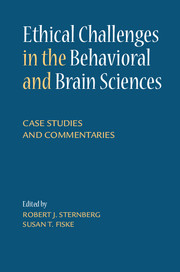Book contents
- Frontmatter
- Contents
- List of Contributors
- Preface
- Part I Academic Cheating
- Part II Academic Excuses and Fairness
- Part III Authorship and Credit
- Part IV Confidentiality’s Limits
- 24 Ethics in Service
- 25 Protecting Confidentiality in a Study of Adolescents’ Digital Communication
- 26 Commentary to Part IV
- Part V Data Analysis, Reporting, and Sharing
- Part VI Designing Research
- Part VII Fabricating Data
- Part VIII Human Subjects
- Part IX Personnel Decisions
- Part X Reviewing and Editing
- Part XI Science for Hire and Conflict of Interest
- Epilogue Why Is Ethical Behavior Challenging?
- Index
- References
25 - Protecting Confidentiality in a Study of Adolescents’ Digital Communication
Published online by Cambridge University Press: 05 February 2015
- Frontmatter
- Contents
- List of Contributors
- Preface
- Part I Academic Cheating
- Part II Academic Excuses and Fairness
- Part III Authorship and Credit
- Part IV Confidentiality’s Limits
- 24 Ethics in Service
- 25 Protecting Confidentiality in a Study of Adolescents’ Digital Communication
- 26 Commentary to Part IV
- Part V Data Analysis, Reporting, and Sharing
- Part VI Designing Research
- Part VII Fabricating Data
- Part VIII Human Subjects
- Part IX Personnel Decisions
- Part X Reviewing and Editing
- Part XI Science for Hire and Conflict of Interest
- Epilogue Why Is Ethical Behavior Challenging?
- Index
- References
Summary
Studying digital communication provides “a window into the secret world of adolescent peer culture” (Greenfield & Yan, 2006, p. 392). According to large, national surveys, 73% of teens (ages 12 to 17) use social networking sites (Lenhart, Purcell, Smith, & Zickuhr, 2010); 51% of teens check social networking sites daily and 22% check them more than 10 times per day (Common Sense Media, 2009). Youth ages 12 to 17 report sending an average of 60 text messages per day (Lenhart, 2012). Many teenagers claim that their social lives would end or be seriously impaired if they could not have access to text messaging (54% of girls and 40% of boys; CTIA, 2008).
This case study describes an ethical dilemma that arose in the context of an ongoing longitudinal study called the BlackBerry Project, in which adolescents were given BlackBerry devices configured to save all of their incoming and outgoing text messages to a secure online archive for later coding and analysis (Underwood, Rosen, More, Ehrenreich, & Gentsch, 2012). Adolescents and their families had been participating in a study of origins and outcomes of aggression since the third grade, and prior to starting ninth grade they were given the BlackBerry devices as a way of investigating their social aggression in the context of digital communication. Following the ethical principle of informed consent, participants and their parents knew text messages sent and received on the BlackBerries were being monitored and archived. Participants were promised confidentiality with regard to content of their digital communication, with a few important exceptions. In keeping with our ethical responsibility to protect our participants from doing harm to self or others, participants understood the limits of confidentiality – that we would alert parents and the appropriate authorities if we saw any text messaging that indicated child or elder abuse, suicidality, or intent to harm others. We obtained a Certificate of Confidentiality that protected us from being required to report other illegal behaviors; participants and parents were informed that we would not report antisocial activities, to them or to any other authorities.
- Type
- Chapter
- Information
- Ethical Challenges in the Behavioral and Brain SciencesCase Studies and Commentaries, pp. 76 - 79Publisher: Cambridge University PressPrint publication year: 2015
References
- 1
- Cited by



